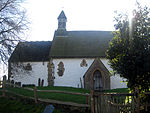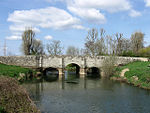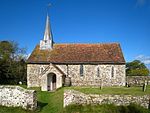St Botolph's Church, Hardham
11th-century church buildings in EnglandChurch of England church buildings in West SussexGrade I listed churches in West SussexHarv and Sfn no-target errorsHorsham District ... and 1 more
Use British English from May 2015

St Botolph's Church is the Church of England parish church of Hardham, West Sussex. It is in Horsham District and is a Grade I listed building. It contains the earliest nearly complete series of wall paintings in England. Among forty individual subjects is the earliest known representation of St. George in England. Dating from the 12th century, they were hidden from view until uncovered in 1866 and now "provide a rare and memorable impression of a medieval painted interior". The simple two-cell stone building, with its original medieval whitewashed exterior, has seen little alteration and also has an ancient bell.
Excerpt from the Wikipedia article St Botolph's Church, Hardham (License: CC BY-SA 3.0, Authors, Images).St Botolph's Church, Hardham
London Road,
Geographical coordinates (GPS) Address Nearby Places Show on map
Geographical coordinates (GPS)
| Latitude | Longitude |
|---|---|
| N 50.948551 ° | E -0.522789 ° |
Address
London Road
RH20 1LB
England, United Kingdom
Open on Google Maps










